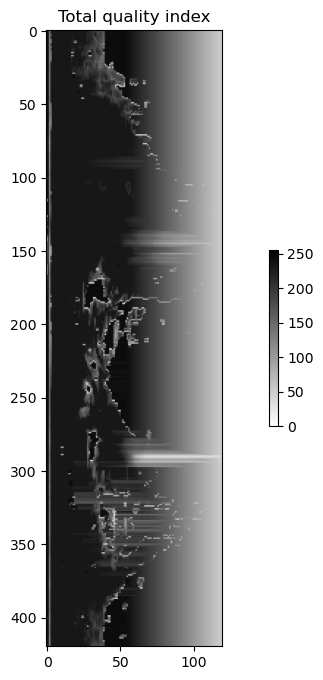retriev data from s3 bucket¶
import os
import urllib.request
from pathlib import Path
# Set the URL for the cloud
URL = "https://js2.jetstream-cloud.org:8001/"
path = "pythia/radar/erad2024/baltrad/baltrad_short_course/"
!mkdir -p data
files = ["201405190715_SUR.h5", "plrze_pvol_20120205T0430Z.h5", "sekir.h5"]
for file in files:
file0 = os.path.join(path, file)
name = os.path.join("data", Path(file).name)
if not os.path.exists(name):
print(f"downloading, {name}")
urllib.request.urlretrieve(
f"{URL}{file0}", os.path.join("data", Path(file).name)
)downloading, data/plrze_pvol_20120205T0430Z.h5
downloading, data/sekir.h5
Import the file I/O module along with the main RAVE module containing useful constants¶
%matplotlib inline
import matplotlib
import _raveio, _raveRead an input ODIM_H5 file¶
rio = _raveio.open("data/201405190715_SUR.h5")Create a simple plotter for B-scans, elaborating the example from the I/O exercise¶
# Two color palettes, one used in GoogleMapsPlugin, and the other from RAVE
from GmapColorMap import dbzh as dbzp
from rave_win_colors import continuous_MS as vradp
# Convert a 768-list palette to a matplotlib colorlist
def make_colorlist(pal):
colorlist = []
for i in range(0, len(pal), 3):
colorlist.append([pal[i] / 255.0, pal[i + 1] / 255.0, pal[i + 2] / 255.0])
return colorlist
# Convert lists to colormaps
dbzcl = make_colorlist(dbzp)
vradcl = make_colorlist(vradp)
# Then create a simple plotter
import matplotlib.pyplot as plt
# from types import StringType
StringType = type("")
def plot(data, colorlist=dbzcl, title="B-scan"):
mini, maxi = data.shape.index(min(data.shape)), data.shape.index(max(data.shape))
figsize = (16, 12) if mini == 0 else (12, 8)
fig = plt.figure(figsize=figsize)
plt.title(title)
clist = (
colorlist
if type(colorlist) == StringType
else matplotlib.colors.ListedColormap(colorlist)
)
plt.imshow(data, cmap=clist, clim=(0, 255))
plt.colorbar(shrink=float(data.shape[mini]) / data.shape[maxi])Access the polar volume and plot VRAD data from the lowest scan¶
pvol = rio.object
plot(pvol.getScan(0).getParameter("VRADH").getData(), vradcl, "Original VRAD")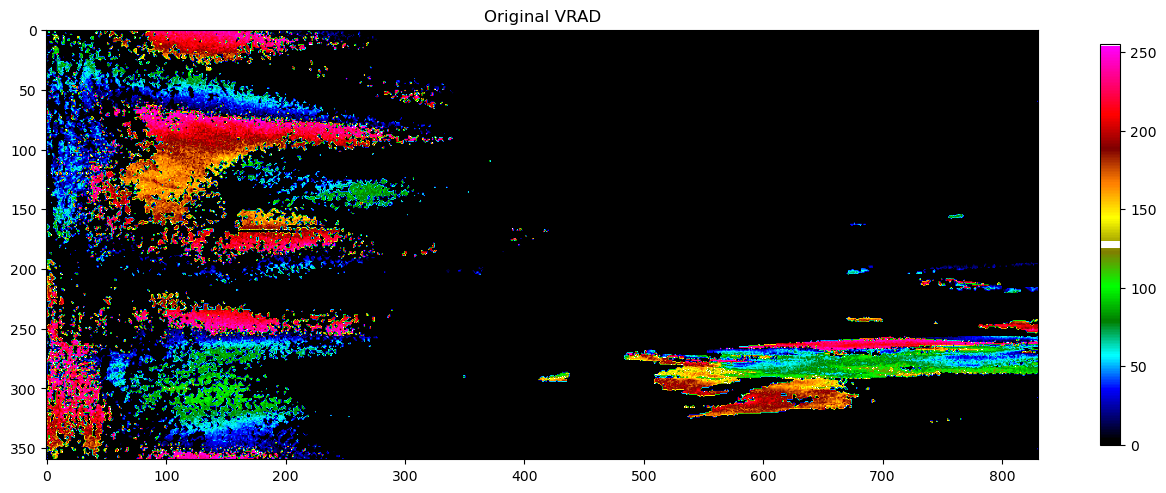
Dealias the volume¶
import _dealias
ret = _dealias.dealias(pvol)Check whether the first scan’s been dealiased¶
print("This first scan is dealiased: %s" % str(_dealias.dealiased(pvol.getScan(0))))This first scan is dealiased: True
Replot for comparison¶
plot(pvol.getScan(0).getParameter("VRADH").getData(), vradcl, "Dealiased VRAD")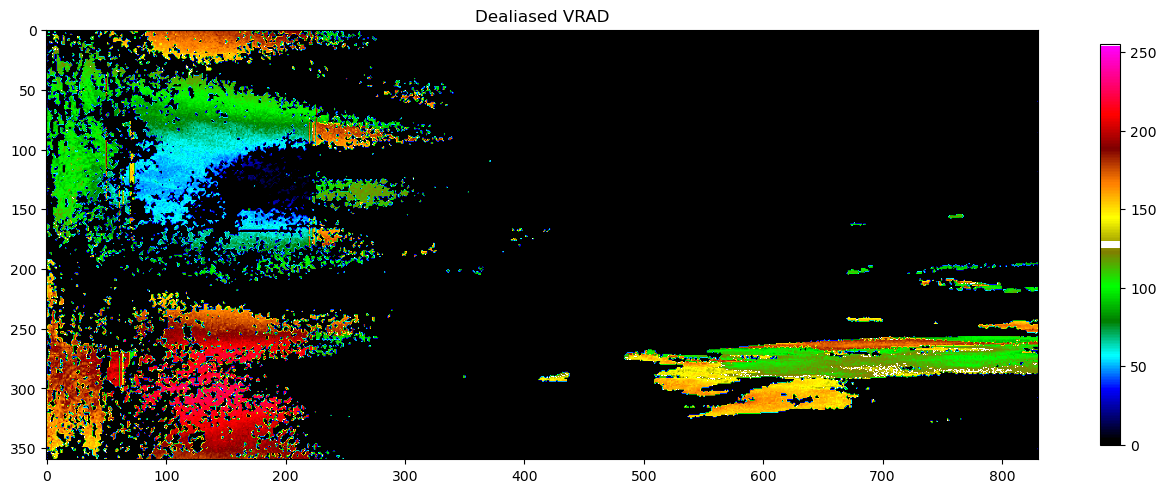
Shift gears - back to reflectivity¶
rio = _raveio.open("data/plrze_pvol_20120205T0430Z.h5")
pvol = rio.object
plot(pvol.getScan(0).getParameter("DBZH").getData(), title="Original DBZH")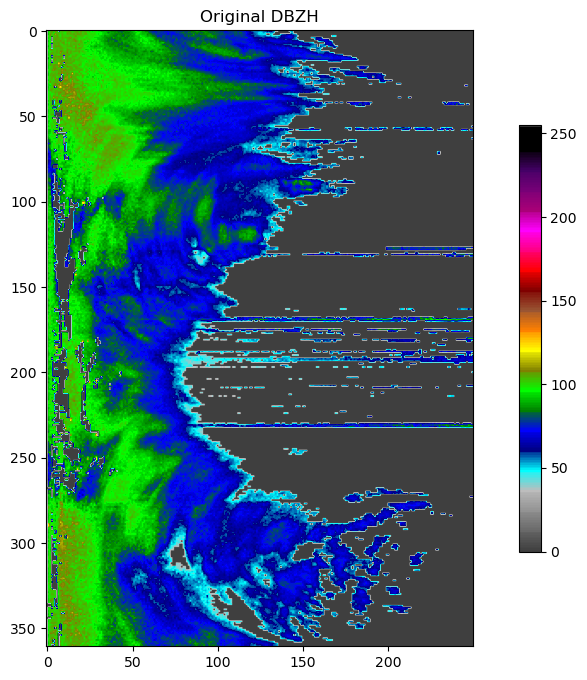
Use the bRopo package’s quality plugin to identify and remove non-precipitation echoes¶
import odc_polarQC
import warnings
warnings.filterwarnings("ignore") # Suppress SyntaxWarning from Python2 code
odc_polarQC.algorithm_ids = ["ropo"]
pvol = odc_polarQC.QC(pvol)Plot the resulting DBZH¶
plot(pvol.getScan(0).getParameter("DBZH").getData(), title="DBZH after bRopo")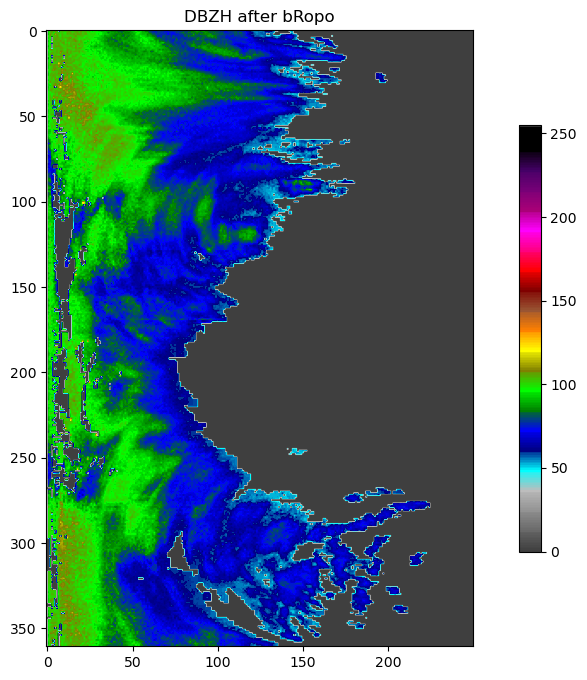
Topographical beam-blockage QC using the beamb package’s quality plugin¶
import time
odc_polarQC.algorithm_ids = ["beamb"]
before = time.time()
pvol = odc_polarQC.QC(pvol)
after = time.time()
print("beamb runtime = %2.2f seconds" % (after - before))beamb runtime = 6.75 seconds
Probability of overshooting¶
odc_polarQC.algorithm_ids = ["rave-overshooting"]
pvol = odc_polarQC.QC(pvol)Accessing and manging data quality fields¶
scan = pvol.getScan(0)
print("Scan contains %i quality fields" % scan.getNumberOfQualityFields())Scan contains 3 quality fields
for i in range(scan.getNumberOfQualityFields()):
qf = scan.getQualityField(i)
print("Quality field %i has identifier %s" % (i, qf.getAttribute("how/task")))Quality field 0 has identifier fi.fmi.ropo.detector.classification
Quality field 1 has identifier se.smhi.detector.beamblockage
Quality field 2 has identifier se.smhi.detector.poo
Plot quality fields¶
Beam blockage¶
bb = scan.getQualityFieldByHowTask("se.smhi.detector.beamblockage")
plot(bb.getData(), "binary", "Quality indicator for beam blockage")
Probability of non-precipitation¶
bb = scan.getQualityFieldByHowTask("fi.fmi.ropo.detector.classification")
plot(bb.getData(), "binary", "Quality indicator for ropo")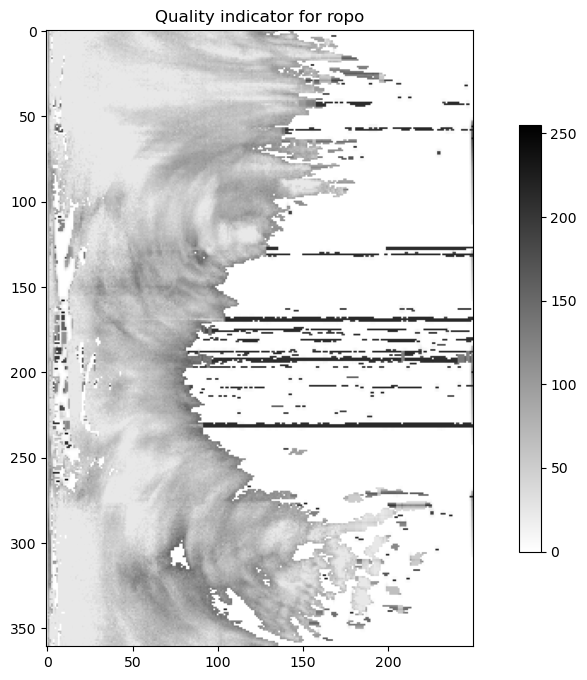
Probability of overshooting¶
bb = scan.getQualityFieldByHowTask("se.smhi.detector.poo")
plot(bb.getData(), "binary", "Quality indicator for PoO")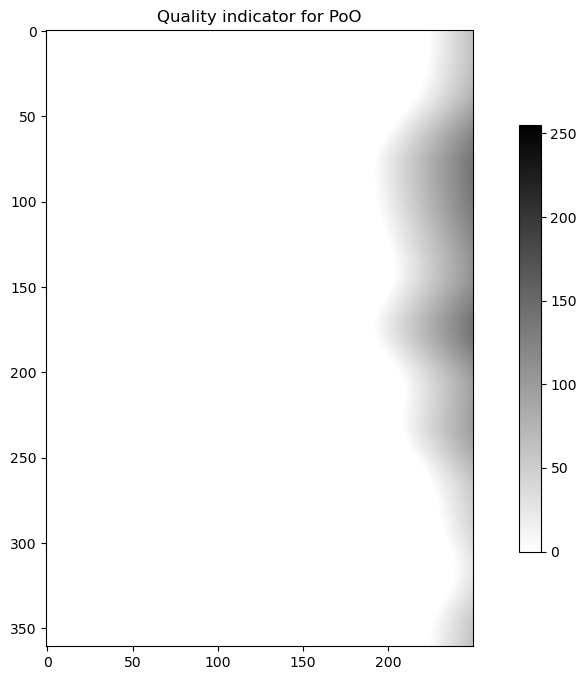
Chaining algorithms - new data¶
rio = _raveio.open("data/sekir.h5")
pvol = rio.object
odc_polarQC.algorithm_ids = [
"ropo",
"beamb",
"radvol-att",
"radvol-broad",
"rave-overshooting",
]
pvol = odc_polarQC.QC(pvol)scan = pvol.getScan(0)
att = scan.getQualityField(2)
plot(att.getData(), "binary", "Attenuation")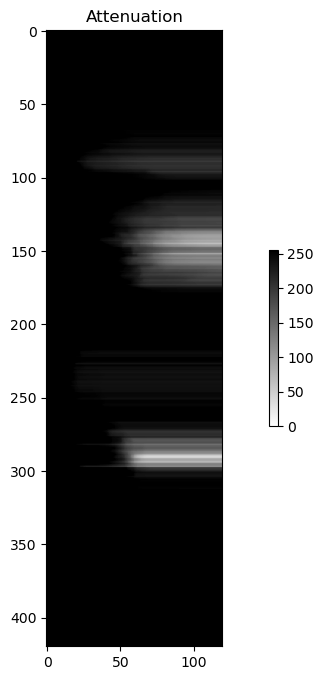
“Total Quality”¶
odc_polarQC.algorithm_ids = ["qi-total"]
pvol = odc_polarQC.QC(pvol)qitot = scan.getQualityField(5)
plot(qitot.getData(), "binary", "Total quality index")